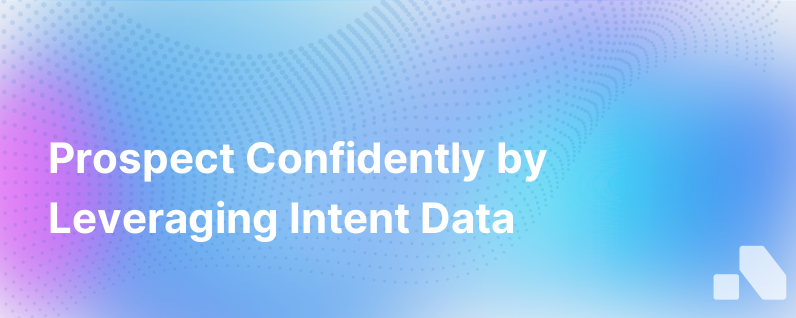
Understanding the intricate web of B2B sales is critical to the success of any company looking to emerge victorious in the modern market. A key thread in unraveling this web is the concept of intent data. Intent data, for the uninitiated, is the digital footprint that provides insights into a potential customer's buying intent. In the competitive arena we navigate, leveraging this data effectively can revolutionize the way you prospect and engage potential customers.
Here's a thorough exploration of intent data and how to integrate it into your prospecting strategy to elevate your B2B sales.
Intent Data Unveiled
Intent data collects and analyzes signals indicating a potential buyer's interest in a product or service. These signals can come from various online activities, such as content consumption, search behavior, and page visits, essentially throwing down bread crumbs along the path to purchase.
There are two primary types of intent data:
- First-party intent data: This is generated through interactions with your company’s own digital properties, such as your website, social media platforms, or email campaigns. It's akin to a guest browsing through the isles of your virtual store.
- Third-party intent data: As the term suggests, this comes from interactions on external platforms, like B2B review sites, industry forums, and publications. It's similar to overhearing a potential customer's conversations in the broader market square.
The Power of Intent Data in Prospecting
Intent data is akin to having a crystal ball to foresee which prospects are worth pursuing. Instead of cold calling or emailing en masse, your sales team can engage in precision targeting, identifying prospects that have shown a palpable interest in solutions like yours.
Advantages of Intent Data Include:
- Prioritization: Intent data illuminates prospects who are actively researching solutions in your category, allowing you to prioritize them over less engaged leads.
- Personalization: By understanding what topics and solutions a prospect is interested in, your outreach can be tailored with precision, resonating more deeply and increasing response rates.
- Timing: By tracking a prospect’s digital signals, you can identify optimal timing for outreach, striking while the iron is hot, so to speak.
- Insight: Intent data offers a wealth of insight into purchasing trends, market interest shifts, and competitive landscapes, enabling strategic decision-making.
Prospect Like a Pro: Intent Data Strategies
When you weave intent data into your prospecting efforts, you're essentially suiting up with market intelligence that positions you multiple steps ahead of contemporaries. Here's how to wield this power effectively.
1. Data Collection and Integration
The journey begins with gathering and integrating data. This means establishing data pipelines from both first and third-party sources and ensuring they flow into your CRM, where they can be analyzed and acted upon.
2. Analytics and Interpretation
Interpreting intent data is as much art as it is science. It necessitates systems capable of deciphering not just volume, but context, separating out noise from actionable intent. Machine learning algorithms shine here, identifying patterns and scoring leads based on their perceived level of interest.
3. Prioritized Outreach
With insights in hand, sales teams can prioritize their efforts towards prospects with the highest buying intent. This is not about discarding the colder leads, but rather warming them up in the background while you chase the hot ones.
4. Tailored Communication
The magic of intent data is in its capacity to inform how you communicate with prospects. Understanding their areas of interest allows for granular customization of messaging, ensuring that communication speaks directly to the prospect's needs and interests.
5. Right-Time Engagement
"Right-time" beats "real-time" any day. With intent data, you're able to identify the moment a prospect's interest is peaking and are thus better poised to engage with contextually relevant, timely content that's more likely to yield a response.
6. Content Strategy Refinement
Intent data doesn't just inform prospecting; it's a goldmine for content strategy as well. By delving into the topics and concerns that prospects are most engaged with, your content strategy can evolve to address these areas more effectively.
7. Competitive Awareness
Keeping a pulse on what the competition is up to is invaluable. Intent data can alert you when potential customers are also considering your competitors, allowing you to adjust your approach or value proposition accordingly.
Overcoming Potential Challenges
Data Overload
A potential pitfall of intent data is the sheer volume and complexity it can introduce. Discerning genuine signals of intent from a sea of data requires robust analytics and prioritization frameworks.
Integration and Actionability
Gathering the data is one thing; making it accessible and actionable within your sales processes is another challenge entirely. Integration with existing CRM and sales systems is paramount, as is the training of your sales team to utilize these insights effectively.
Privacy and Compliance
With great data comes great responsibility. Ensuring compliance with global data privacy regulations like GDPR and CCPA is non-negotiable when dealing with intent data.
In Conclusion
Confident prospecting with intent data isn’t just about leaning on technology — it’s about transforming your sales culture into one that’s guided by insights, responsiveness, and agility. By skilfully integrating intent data into your prospecting strategy, you can engage with potential buyers in a manner that's simultaneously more precise and personable, setting yourself apart from the competition and building the kind of credibility that turns prospects into customers.
Empowering your sales team with intent data paves the way for tailored interactions that resonate with prospects, fostering deeper connections and maximizing chances of conversion. Remember, prospecting isn't about casting the widest net — it's about casting the smartest one.
While there are challenges to navigate, especially when it comes to managing and maintaining high-quality intent data, the possibilities for transformation and growth are vast. For those willing to harness the power of intent data, the future of B2B sales is filled with confidence and success.